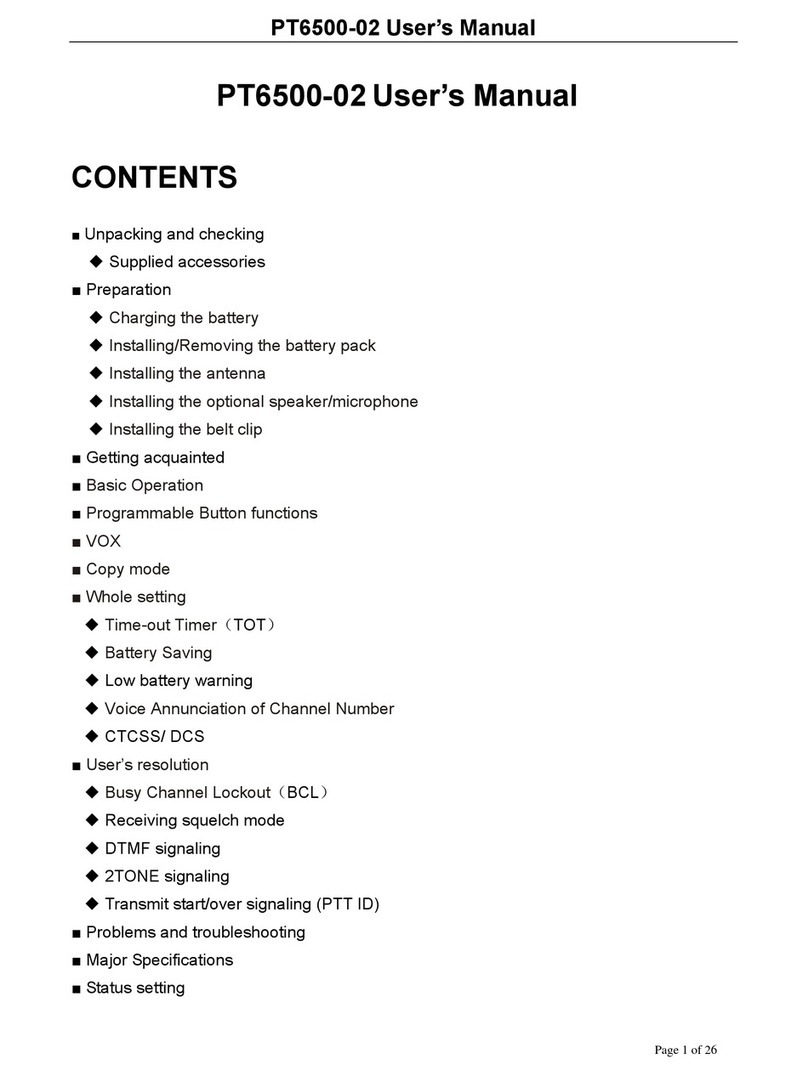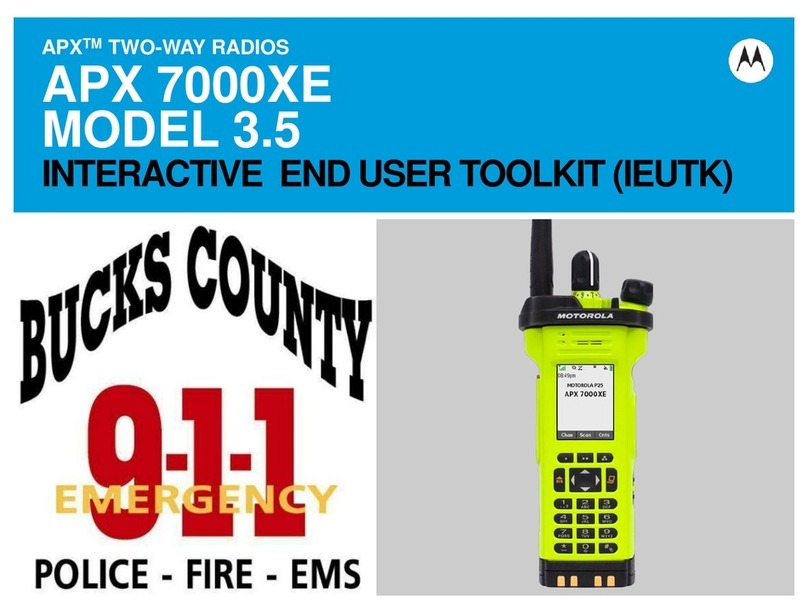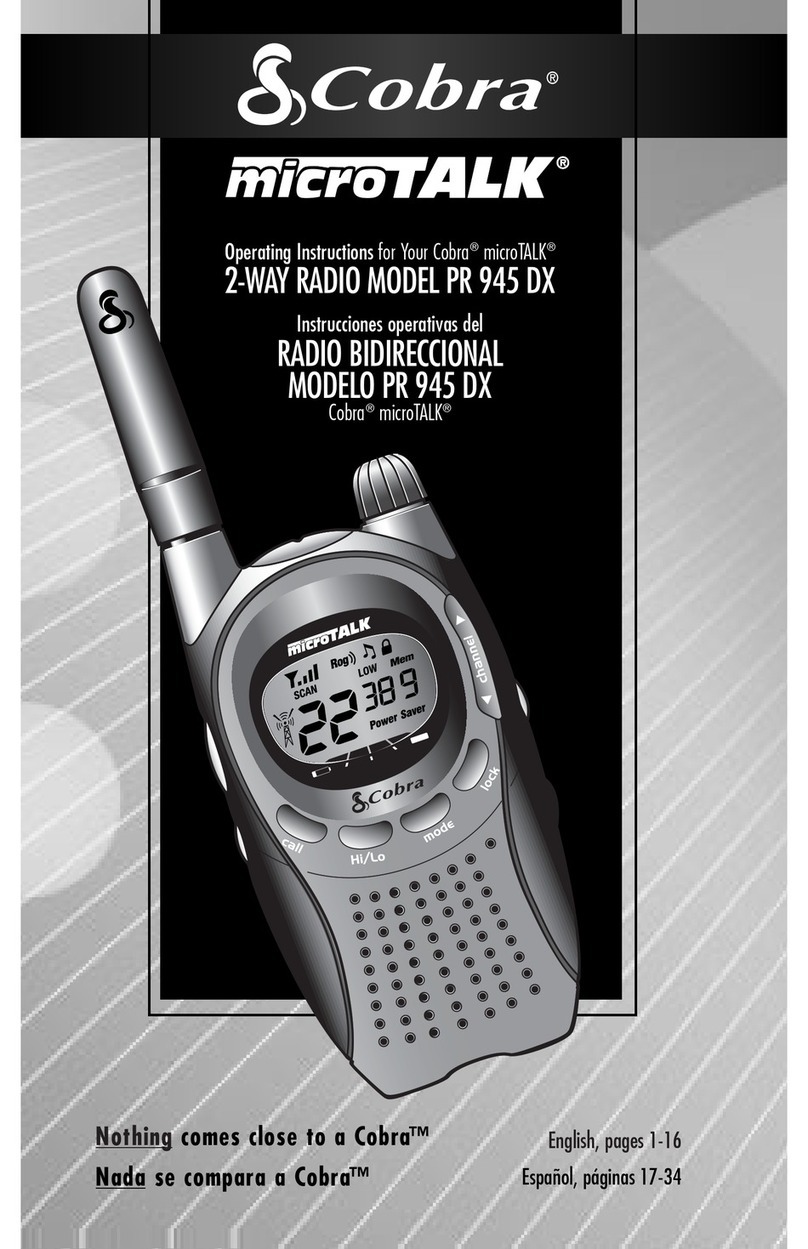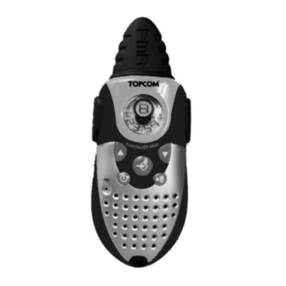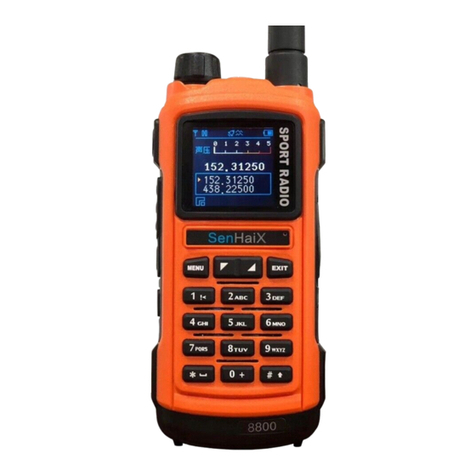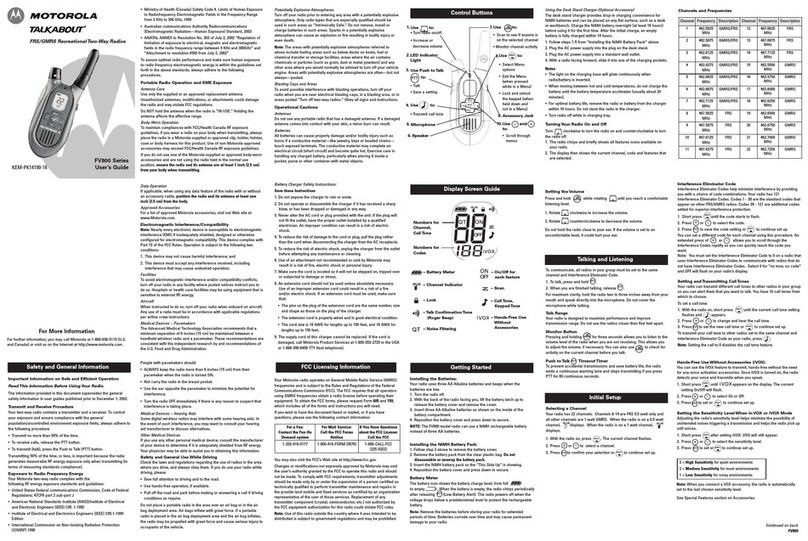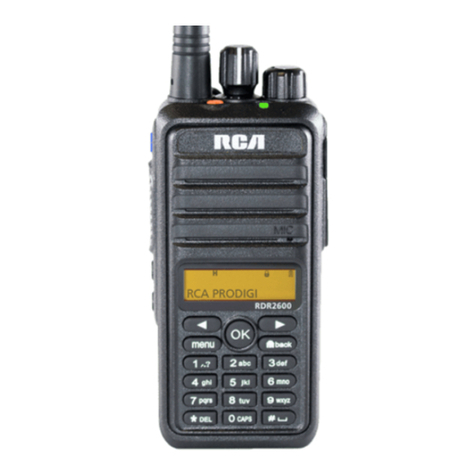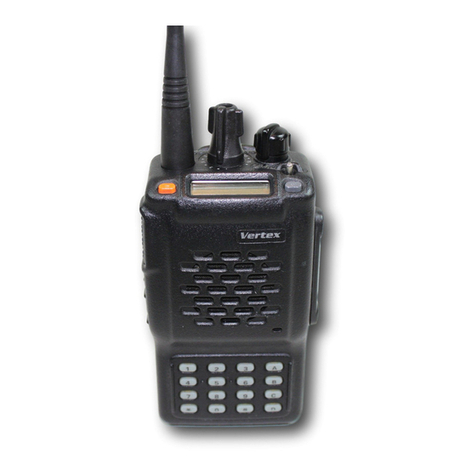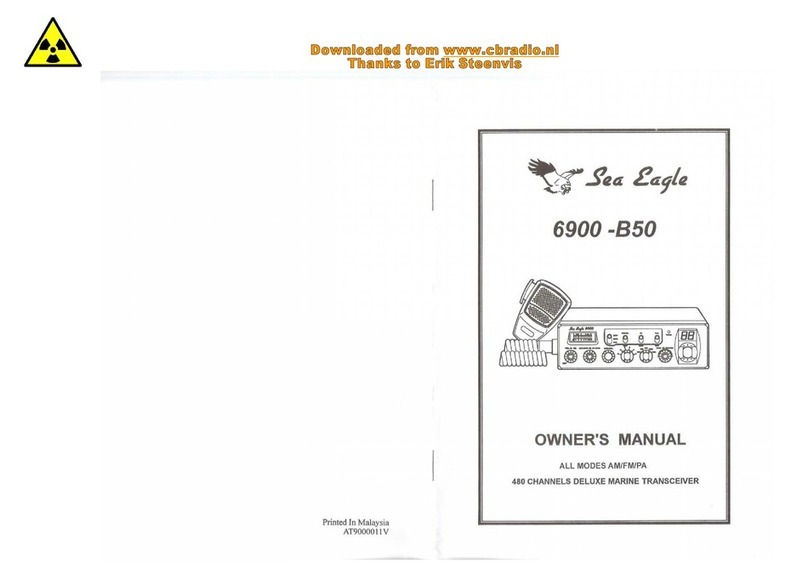Mountain Lab Gear SCOUT 2W User manual

OPERATING INSTRUCTIONS
MOUNTAIN LAB GEAR
SCOUT 2W 2-WAY RADIO
Note:
Please read the operating instructions carefully
before using the device.

KEY FUNCTIONS
7
8
9
10
Speaker
Microphone
Monitor/Scan
Lock/Menu
Speaker Microphone
Accessory Port
7
8
9
10
11
11
1
2
3
4
5
Push-To-Talk (PTT)
Power/Call Tone
Lamp/Weather
Signal Light Button
LED Light
Signal Light
1
2
3
4
5
6
6
1

GETTING STARTED
Install the AA NiMH Rechargeable Batteries
1. Remove the belt clip by inserting a finger under the tab at the top
and sliding the belt clip up.
2. Remove the two screws on the back of the radio by turning them
counter-clockwise to open the cover.
DISPLAY SCREEN GUIDE
Channel Number
Sub-code
Dual Channel
Scan
VOX
Battery Life
Status
(Transmit/Receive)
Volume Mute
Keypad Lock
Weather Alert
Remove the
battery cover.
screws
2

Insert 3 AA NiMH
batteries.
Close the battery
cover.
Battery Life
3. Install the included AA NiMH batteries according to the
orientation shown in the battery compartment.
4. Close the battery compartment cover and replace the screws,
turning clockwise until snug.
A fully charged battery is indicated by three solid bars .
When the battery is low, the display will show one blinking bar
and the radio will emit a low battery warning beep after each
transmission.
Note:
• Remove the batteries from the radio prior to storage. Batteries left
in the radio during storage may corrode over time and may cause
permanent damage to your radio.
• Do not mix old and new or alkaline and NiMH batteries.
• Charge the supplied NiMH batteries once every three
months when not in use.
3

1. Press to increase the volume (maximum volume is 7).
Press to decrease the volume (minimum volume is 1).
2. When volume level 0 is selected, the radio is muted and
is displayed.
Using the Charging Dock
The Micro-USB charging dock allows you to conveniently charge
the NiMH battery of your SCOUT radio in the dedicated dock,
using the included certified charging adaptor (5V, ≥1A).
Note: Do not attempt to charge alkaline batteries.
How To Charge the Battery
1. Ensure that your radio is turned OFF.
2. Plug the Micro-USB cable into the Micro-USB port on the
charging dock. Insert the USB connector into the charging
adapter. Plug the charging adapter into a household electrical
outlet.
3. Place the radio into the charging dock. The battery meter on the
display will cycle to indicate the battery is charging. The battery
is fully charged when the display shows three solid bars.
BASIC OPERATION
Turning the Radio On and Off
1. Press and hold the power button to turn your radio on/off.
2. The display will show the current channel, sub-code and
enabled features.
Setting the Volume
4

1. Press the button. The channel number will start to flash.
2. Press or to change the channel number.
3. Press the PTT button to select the channel and exit the
menu, or press again to proceed to the sub-code
selection menu.
Setting the Channel
CH Frequency
(MHz)
Max
Power
Out put (MHz)
Frequency Max
Power
Out put
1 462.5625 2W 12 467.6625 0.5W
2 462.5875 2W 13 467.6875 0.5W
3 462.6125 2W 14 467.7125 0.5W
4 462.6375 2W 15 462.5500 2W
5 462.6625 2W 16 462.5750 2W
6 462.6875 2W 17 462.6000 2W
7 462.7125 2W 18 462.6250 2W
8 467.5625 0.5W 19 462.6500 2W
9 467.5875 0.5W 20 462.6750 2W
10 467.6125 0.5W 21 462.7000 2W
11 467.6375 0.5W 22 462.7250 2W
CH
Channels and Frequencies
5

1. Press the button until the sub-code number starts to
flash.
2. Press or to change the sub-code number.
3. Press the PTT button to exit the menu.
Note: When sub-code “0” is selected, the radio can receive
transmissions from any radio on the same channel, regardless
of sub-code. However, only those radios also on sub-code “0”
will be able to receive its transmissions.
If the PTT button is held for longer than 60 seconds, radio will stop
transmitting. This is to prevent accidental transmission.
1. To talk, press and hold the PTT button. When transmitting, the
icon is shown. Release the PTT button when you are
finished talking. Do not use the radios closer than two meters
apart or the radios may experience feedback.
2. When receiving a transmission, the icon will be displayed.
Note: With all radios, it is good practice to hold the PTT button for
a half second longer before and after speaking to ensure your
transmission is not cut off.
PTT Timeout Timer
Setting the Sub-Code
Transmitting and Receiving
6

The scan function allows the user to listen for any activity on
any channel and its matched sub-code (as is selected in the
main menu).
1. Press the button to start scanning. The “SCAN” icon will
show and the display will cycle through the channels and
sub-codes being scanned for activity.
2. When activity is detected, the radio will stop scanning and
receive the transmission. At the end of transmission, press
the PTT button within five seconds to respond. Otherwise the
radio will resume scanning.
3. If the PTT button is pressed while the device is scanning, the
transmission will be sent on the main selected channel.
4. Press the button to exit scan mode.
Note: If the device stops on an unintended/undesired
transmission, press or to resume scan OR temporarily
remove that channel from the scan list by pressing and holding
or for three seconds.
To restore removed channels to the scan list, press to exit
and re-enter scan mode.
To transmit a call tone, press the button.
Setting the Call Tone
1. To select the call tone to be used, press the button until
the call tone menu “CA” appears. The flashing number
indicates the current call tone.
2. Press or to change the call tone.
3. Press the PTT button to exit the menu.
Note: Call tone “0” mutes the call tone feature. No call tone will
be sent, but they can still be received.
Call Tone
The keypad lock feature prevents accidental keypad button
activation. This is especially useful when the radio is used with
the included speaker microphone accessory and placed inside
a backpack or otherwise secured.
1. To lock the keypad buttons, press and hold the button
until the lock indicator is displayed.
2. Repeat the procedure to unlock the keypad.
Keypad Lock
Scan
KEYPAD FEATURES
7

Monitor mode can be used to listen for weak signals or to check
activity on the current channel.
1. Press and hold for three seconds to enter monitor mode.
2. Release the button to exit monitor mode.
The scan function allows the user to listen for any activity on
any channel and its matched sub-code (as is selected in the
main menu).
1. Press the button to start scanning. The “SCAN” icon will
show and the display will cycle through the channels and
sub-codes being scanned for activity.
2. When activity is detected, the radio will stop scanning and
receive the transmission. At the end of transmission, press
the PTT button within five seconds to respond. Otherwise the
radio will resume scanning.
3. If the PTT button is pressed while the device is scanning, the
transmission will be sent on the main selected channel.
4. Press the button to exit scan mode.
Note: If the device stops on an unintended/undesired
transmission, press or to resume scan OR temporarily
remove that channel from the scan list by pressing and holding
or for three seconds.
To restore removed channels to the scan list, press to exit
and re-enter scan mode.
Monitor
Press the button to turn on/off the lamp. The lamp feature
is disabled by the keypad lock.
LED Lamp
In weather mode, your radio can receive NOAA weather
information, warnings and alerts.
Press and hold the button for three seconds to enter or
exit weather mode.
Weather
8

Setting the Weather Channel
1. In weather mode, press the button until the weather
channel number flashes.
2. Press or to select the appropriate channel for your area.
3. Press the PTT button to set the channel and exit the menu.
Setting the Weather Alert
You radio can be set to respond to NOAA Weather Radio
emergency messages.
1. In weather mode, press the button twice. The icon will
be displayed.
2. Press or to turn weather alert on or off.
3. Press the PTT button or to exit the weather alert menu.
4. Repeat the step to disable the weather alert.
2. When activity is detected, the radio will stop scanning and
receive the transmission. At the end of transmission, press
the PTT button within five seconds to respond. Otherwise the
radio will resume scanning.
3. If the PTT button is pressed while the device is scanning, the
transmission will be sent on the main selected channel.
4. Press the button to exit scan mode.
Note: If the device stops on an unintended/undesired
transmission, press or to resume scan OR temporarily
remove that channel from the scan list by pressing and holding
or for three seconds.
To restore removed channels to the scan list, press to exit
and re-enter scan mode.
Weather
WEATHER CHANNELS & FREQUENCIES
Weather
Channel (MHz)
Frequency Weather
Channel
Frequency
(MHz)
WX1 162.550 WX7 162.525
WX2 162.400 WX8 161.650
WX3 162.475 WX9 161.775
WX4 162.425 WX10 161.750
WX5 162.450 WX11 162.000
WX6 162.500
9

Voice-operated transmission allows the user to send
transmissions without pressing the PTT button. The radio will
detect an increase in sound levels and transmit automatically.
1. To activate VOX, press the button until “VOX” appears
on the display, along with a flashing number (0-3).
2. Press or to change the VOX sensitivity level (1-3) or
turn off (0).
• 0 = VOX function off
• 1 = Low sensitivity
• 2 = Medium sensitivity
• 3 = High sensitivity
3. Press the PTT button to exit the menu.
Note: The PTT button can still be used to send transmissions
in VOX mode.
The signal light button can be used to emit an emergency call
tone and SOS flashing light. This feature should only be used
in a real emergency to increase visibility.
Note: This device does not have the capability to contact
emergency services or provide any location information, and
should not be confused with a dedicated personal locator
device that is designed to do so.
1. Press and hold the SOS button for three seconds. The red
LED light will begin to flash the SOS signal light and an
emergency tone will be transmitted.
2. To cancel the emergency signal light, press the SOS button
once more.
Signal Light (SOS)
Voice-Operated Transmission (VOX)
MENU FEATURES
10

1. Press the button until the power selection menu “Pr”
appears.
2. Press or to select the flashing “HI” or “LO” power.
Note: High power (2 watts) is only available on channels 1-7 and
15-22. Channels 8-14 are restricted to Low power (0.5 watts)
only, in accordance with governmental regulation.
3. Press the PTT button to exit the menu.
High power is indicated on the main display (indicated by “HI”) when
channels 1-7 or 15-22 are selected.
Note: The power setting does not affect the ability of the radio to
receive transmissions. Only the output power is affected by this setting.
Dual channel monitor allows the user to listen for transmissions
on two channels at the same time—the main channel and
sub-code as set on in the main menu, and a second channel
and sub-code.
1. Press the button until the dual channel monitor menu
“2CH” appears. The flashing number indicates the current
secondary channel to be monitored (1-22), and “OF”
indicates that the feature is turned off.
2. Press or to select which secondary channel to
monitor.
Note: There is no option to select a sub-code in the dual channel
monitor menu. The sub-code is dictated by the sub-code that is
selected for that channel in the main sub-code menu setting. For
example: If the main channel setting for channel 5 is set to
sub-code 121, then that will be the sub-code used for the channel
5 dual channel monitor selection.
3. Press the PTT button to exit the menu.
In dual channel monitor mode, the display will alternate
between the main channel (and sub-code) setting and the dual
channel secondary channel.
In the case that a transmission is received on the secondary
dual channel monitor channel, any transmissions made within
10 seconds of receiving will be occur on the secondary
channel. Otherwise, all transmissions will be made on the main
channel and sub-code setting.
Dual Channel Monitor (2CH)
Setting High and Low Transmission Power
Any changes or modifications not expressly approved by the
party responsible for compliance could void the user's authority
to operate the equipment.
This device complies with part 15 of the FCC Rules. Operation
is subject to the following two conditions: (1) This device may
not cause harmful interference, and (2) this device must accept
any interference received, including interference that may
cause undesired operation.
Note: This equipment has been tested and found to comply
with the limits for a Class B digital device, pursuant to part 15
of the FCC Rules. These limits are designed to provide
reasonable protection against harmful interference in a
residential installation. This equipment generates, uses and can
radiate radio frequency energy and, if not installed and used in
accordance with the instructions, may cause harmful
interference to radio communications. However, there is no
guarantee that interference will not occur in a particular
installation. If this equipment does cause harmful interference to
radio or television reception, which can be determined by turning
the equipment off and on, the user is encouraged to try to
correct the interference by one or more of the following
measures:
• Reorient or relocate the receiving antenna.
• Increase the separation between the equipment and receiver.
• Connect the equipment into an outlet on a circuit different from
that to which the receiver is connected.
• Consult the dealer or an experienced radio/TV technician for help.
Safety Information for Radios
Your wireless handheld portable transceiver contains a low power
transmitter. When the talk button is pushed, it sends out radio
frequency (RF) signals. The device is authorized to operate at a
duty factor not to exceed 50%. In August 1996, the Federal
Communications Commissions (FCC) adopted RF exposure
guidelines with safety levels for handheld wireless devices.
Important
FCC RF Exposure Requirements: For body-worn operation, this
radio has been tested and meets the FCC RF exposure guidelines
when used with accessories supplied or designated for this product.
Use of other accessories may not ensure compliance with FCC RF
exposure guidelines. Use only the supplied antenna. Unauthorized
antennas, modifications or attachments could damage the
transmitter and may violate FCC regulations.
Normal Position
Hold the transmitter approximately 25 mm from your face and
speak in a normal voice, with the antenna pointed up and away.
11

1. Press the button until the power selection menu “Pr”
appears.
2. Press or to select the flashing “HI” or “LO” power.
Note: High power (2 watts) is only available on channels 1-7 and
15-22. Channels 8-14 are restricted to Low power (0.5 watts)
only, in accordance with governmental regulation.
3. Press the PTT button to exit the menu.
High power is indicated on the main display (indicated by “HI”) when
channels 1-7 or 15-22 are selected.
Note: The power setting does not affect the ability of the radio to
receive transmissions. Only the output power is affected by this setting.
Any changes or modifications not expressly approved by the
party responsible for compliance could void the user's authority
to operate the equipment.
This device complies with part 15 of the FCC Rules. Operation
is subject to the following two conditions: (1) This device may
not cause harmful interference, and (2) this device must accept
any interference received, including interference that may
cause undesired operation.
Note: This equipment has been tested and found to comply
with the limits for a Class B digital device, pursuant to part 15
Keypad Tone On/Off
Press and hold the button while turning the radio on to turn the
keypad tone off or back on.
Roger Tone On/Off
Press and hold the button while turning the radio on to turn the
roger beep (PTT transmit beep) off or back on.
Automatic Power Saving
This feature turns off the display automatically when not in use to
save battery life.
Water Activated LED
If the radio is dropped in water, a flashing white LED light will be
activated automatically to assist in finding the dropped radio in
darkness. After retrieving the radio, press any button to
deactivate the flashing light.
ADDITIONAL FEATURES
of the FCC Rules. These limits are designed to provide
reasonable protection against harmful interference in a
residential installation. This equipment generates, uses and can
radiate radio frequency energy and, if not installed and used in
accordance with the instructions, may cause harmful
interference to radio communications. However, there is no
guarantee that interference will not occur in a particular
installation. If this equipment does cause harmful interference to
radio or television reception, which can be determined by turning
the equipment off and on, the user is encouraged to try to
correct the interference by one or more of the following
measures:
• Reorient or relocate the receiving antenna.
• Increase the separation between the equipment and receiver.
• Connect the equipment into an outlet on a circuit different from
that to which the receiver is connected.
• Consult the dealer or an experienced radio/TV technician for help.
Safety Information for Radios
Your wireless handheld portable transceiver contains a low power
transmitter. When the talk button is pushed, it sends out radio
frequency (RF) signals. The device is authorized to operate at a
duty factor not to exceed 50%. In August 1996, the Federal
Communications Commissions (FCC) adopted RF exposure
guidelines with safety levels for handheld wireless devices.
Important
FCC RF Exposure Requirements: For body-worn operation, this
radio has been tested and meets the FCC RF exposure guidelines
when used with accessories supplied or designated for this product.
Use of other accessories may not ensure compliance with FCC RF
exposure guidelines. Use only the supplied antenna. Unauthorized
antennas, modifications or attachments could damage the
transmitter and may violate FCC regulations.
Normal Position
Hold the transmitter approximately 25 mm from your face and
speak in a normal voice, with the antenna pointed up and away.
12

Any changes or modifications not expressly approved by the
party responsible for compliance could void the user's authority
to operate the equipment.
This device complies with part 15 of the FCC Rules. Operation
is subject to the following two conditions: (1) This device may
not cause harmful interference, and (2) this device must accept
any interference received, including interference that may
cause undesired operation.
Note: This equipment has been tested and found to comply
with the limits for a Class B digital device, pursuant to part 15
Code
No Frequency
(Hz) Code
No Frequency
(Hz) Code
No Frequency
(Hz) Code
No Frequency
(Hz)
1 67
71.9
74.4
77
79.7
82.5
85.4
88.5
91.5
94.8
97.4
100
103.5
107.2
110.9
114.8
118.8
123
127.3
131.8
136.5
141.3
146.2
151.4
156.7
162.2
167.9
173.8
179.9
186.2
192.8
203.5
210.7
218.1
225.7
233.6
241.8
250.3
2
3
4
5
6
7
8
9
11
12
13
14
15
16
17
18
19
21
22
23
24
25
26
27
31
32
33
34
35
36
37
28 38
29
10 20 30
No Code No Code No Code No Code
39 23
25
26
31
32
43
47
51
54
65
71
72
73
74
114
115
116
125
131
132
134
143
152
155
156
162
165
172
174
205
223
226
243
244
245
251
261
265
271
263
40
41
42
43
44
45
46
47
49
50
51
52
53
54
55
56
57
59
60
61
62
63
64
65
69
70
71
72
73
74
75
66 76
77
78
67
48 58 68
RADIO FREQUENCIES
CTCSS 38
of the FCC Rules. These limits are designed to provide
reasonable protection against harmful interference in a
residential installation. This equipment generates, uses and can
radiate radio frequency energy and, if not installed and used in
accordance with the instructions, may cause harmful
interference to radio communications. However, there is no
guarantee that interference will not occur in a particular
installation. If this equipment does cause harmful interference to
radio or television reception, which can be determined by turning
the equipment off and on, the user is encouraged to try to
correct the interference by one or more of the following
measures:
• Reorient or relocate the receiving antenna.
• Increase the separation between the equipment and receiver.
• Connect the equipment into an outlet on a circuit different from
that to which the receiver is connected.
• Consult the dealer or an experienced radio/TV technician for help.
Safety Information for Radios
Your wireless handheld portable transceiver contains a low power
transmitter. When the talk button is pushed, it sends out radio
frequency (RF) signals. The device is authorized to operate at a
duty factor not to exceed 50%. In August 1996, the Federal
Communications Commissions (FCC) adopted RF exposure
guidelines with safety levels for handheld wireless devices.
Important
FCC RF Exposure Requirements: For body-worn operation, this
radio has been tested and meets the FCC RF exposure guidelines
when used with accessories supplied or designated for this product.
Use of other accessories may not ensure compliance with FCC RF
exposure guidelines. Use only the supplied antenna. Unauthorized
antennas, modifications or attachments could damage the
transmitter and may violate FCC regulations.
Normal Position
Hold the transmitter approximately 25 mm from your face and
speak in a normal voice, with the antenna pointed up and away.
13

Any changes or modifications not expressly approved by the
party responsible for compliance could void the user's authority
to operate the equipment.
This device complies with part 15 of the FCC Rules. Operation
is subject to the following two conditions: (1) This device may
not cause harmful interference, and (2) this device must accept
any interference received, including interference that may
cause undesired operation.
Note: This equipment has been tested and found to comply
with the limits for a Class B digital device, pursuant to part 15
FCC Warning
No Code No Code No Code No Code
79 306
311
315
331
343
346
351
364
365
371
412
413
423
431
432
445
464
465
466
503
516
532
546
565
606
612
624
627
631
632
662
664
703
712
723
731
732
734
743
754
80
81
82
83
84
85
86
87
90
91
92
93
94
95
96
97
98
101
102
103
104
105
106
107
112
113
114
115
116
117
118
108 119
120
121
109
88 99 110
411 506 65489 100 111
SAFETY AND GENERAL INFORMATION
CDCSS 83
of the FCC Rules. These limits are designed to provide
reasonable protection against harmful interference in a
residential installation. This equipment generates, uses and can
radiate radio frequency energy and, if not installed and used in
accordance with the instructions, may cause harmful
interference to radio communications. However, there is no
guarantee that interference will not occur in a particular
installation. If this equipment does cause harmful interference to
radio or television reception, which can be determined by turning
the equipment off and on, the user is encouraged to try to
correct the interference by one or more of the following
measures:
• Reorient or relocate the receiving antenna.
• Increase the separation between the equipment and receiver.
• Connect the equipment into an outlet on a circuit different from
that to which the receiver is connected.
• Consult the dealer or an experienced radio/TV technician for help.
Safety Information for Radios
Your wireless handheld portable transceiver contains a low power
transmitter. When the talk button is pushed, it sends out radio
frequency (RF) signals. The device is authorized to operate at a
duty factor not to exceed 50%. In August 1996, the Federal
Communications Commissions (FCC) adopted RF exposure
guidelines with safety levels for handheld wireless devices.
Important
FCC RF Exposure Requirements: For body-worn operation, this
radio has been tested and meets the FCC RF exposure guidelines
when used with accessories supplied or designated for this product.
Use of other accessories may not ensure compliance with FCC RF
exposure guidelines. Use only the supplied antenna. Unauthorized
antennas, modifications or attachments could damage the
transmitter and may violate FCC regulations.
Normal Position
Hold the transmitter approximately 25 mm from your face and
speak in a normal voice, with the antenna pointed up and away.
14

Any changes or modifications not expressly approved by the
party responsible for compliance could void the user's authority
to operate the equipment.
This device complies with part 15 of the FCC Rules. Operation
is subject to the following two conditions: (1) This device may
not cause harmful interference, and (2) this device must accept
any interference received, including interference that may
cause undesired operation.
Note: This equipment has been tested and found to comply
with the limits for a Class B digital device, pursuant to part 15
of the FCC Rules. These limits are designed to provide
reasonable protection against harmful interference in a
residential installation. This equipment generates, uses and can
radiate radio frequency energy and, if not installed and used in
accordance with the instructions, may cause harmful
interference to radio communications. However, there is no
guarantee that interference will not occur in a particular
installation. If this equipment does cause harmful interference to
radio or television reception, which can be determined by turning
the equipment off and on, the user is encouraged to try to
correct the interference by one or more of the following
measures:
• Reorient or relocate the receiving antenna.
• Increase the separation between the equipment and receiver.
• Connect the equipment into an outlet on a circuit different from
that to which the receiver is connected.
• Consult the dealer or an experienced radio/TV technician for help.
Safety Information for Radios
Your wireless handheld portable transceiver contains a low power
transmitter. When the talk button is pushed, it sends out radio
frequency (RF) signals. The device is authorized to operate at a
duty factor not to exceed 50%. In August 1996, the Federal
Communications Commissions (FCC) adopted RF exposure
guidelines with safety levels for handheld wireless devices.
Important
FCC RF Exposure Requirements: For body-worn operation, this
radio has been tested and meets the FCC RF exposure guidelines
when used with accessories supplied or designated for this product.
Use of other accessories may not ensure compliance with FCC RF
exposure guidelines. Use only the supplied antenna. Unauthorized
antennas, modifications or attachments could damage the
transmitter and may violate FCC regulations.
Normal Position
Hold the transmitter approximately 25 mm from your face and
speak in a normal voice, with the antenna pointed up and away.
15

Any changes or modifications not expressly approved by the
party responsible for compliance could void the user's authority
to operate the equipment.
This device complies with part 15 of the FCC Rules. Operation
is subject to the following two conditions: (1) This device may
not cause harmful interference, and (2) this device must accept
any interference received, including interference that may
cause undesired operation.
Note: This equipment has been tested and found to comply
with the limits for a Class B digital device, pursuant to part 15
of the FCC Rules. These limits are designed to provide
reasonable protection against harmful interference in a
residential installation. This equipment generates, uses and can
radiate radio frequency energy and, if not installed and used in
accordance with the instructions, may cause harmful
interference to radio communications. However, there is no
guarantee that interference will not occur in a particular
installation. If this equipment does cause harmful interference to
radio or television reception, which can be determined by turning
the equipment off and on, the user is encouraged to try to
correct the interference by one or more of the following
measures:
• Reorient or relocate the receiving antenna.
• Increase the separation between the equipment and receiver.
• Connect the equipment into an outlet on a circuit different from
that to which the receiver is connected.
• Consult the dealer or an experienced radio/TV technician for help.
Safety Information for Radios
Your wireless handheld portable transceiver contains a low power
transmitter. When the talk button is pushed, it sends out radio
frequency (RF) signals. The device is authorized to operate at a
duty factor not to exceed 50%. In August 1996, the Federal
Communications Commissions (FCC) adopted RF exposure
guidelines with safety levels for handheld wireless devices.
Important
FCC RF Exposure Requirements: For body-worn operation, this
radio has been tested and meets the FCC RF exposure guidelines
when used with accessories supplied or designated for this product.
Use of other accessories may not ensure compliance with FCC RF
exposure guidelines. Use only the supplied antenna. Unauthorized
antennas, modifications or attachments could damage the
transmitter and may violate FCC regulations.
Normal Position
Hold the transmitter approximately 25 mm from your face and
speak in a normal voice, with the antenna pointed up and away.
Warnings
Product safety and RF Exposure for two way radio:
Before using this two way radio, please read the
manual which contains important operating
instructions for safe usage, RF Energy Awareness,
control information and operational instructions for
compliance with RF Energy Exposure limits in
applicable national and international standards, and
also read the operational instructions for safe use.
Test position and configuration Head SAR was performed with
the device configured in the positions according to IEEE1528,
and face up SAR was performed with the device 25mm from the
phantom. Body SAR was performed with the belt clip on the
device 0 mm from the phantom. Body SAR was also performed
with the headset attached and without.
Antennas
CAUTION
WARNING
1. The antenna is unique to this product. Please do not attempt
to alter or replace.
2. For safe operation, the antenna for the product shall be least
25mm away from your face when speaking.
16

Any changes or modifications not expressly approved by the
party responsible for compliance could void the user's authority
to operate the equipment.
This device complies with part 15 of the FCC Rules. Operation
is subject to the following two conditions: (1) This device may
not cause harmful interference, and (2) this device must accept
any interference received, including interference that may
cause undesired operation.
Note: This equipment has been tested and found to comply
with the limits for a Class B digital device, pursuant to part 15
of the FCC Rules. These limits are designed to provide
reasonable protection against harmful interference in a
residential installation. This equipment generates, uses and can
radiate radio frequency energy and, if not installed and used in
accordance with the instructions, may cause harmful
interference to radio communications. However, there is no
guarantee that interference will not occur in a particular
installation. If this equipment does cause harmful interference to
radio or television reception, which can be determined by turning
the equipment off and on, the user is encouraged to try to
correct the interference by one or more of the following
measures:
• Reorient or relocate the receiving antenna.
• Increase the separation between the equipment and receiver.
• Connect the equipment into an outlet on a circuit different from
that to which the receiver is connected.
• Consult the dealer or an experienced radio/TV technician for help.
Safety Information for Radios
Your wireless handheld portable transceiver contains a low power
transmitter. When the talk button is pushed, it sends out radio
frequency (RF) signals. The device is authorized to operate at a
duty factor not to exceed 50%. In August 1996, the Federal
Communications Commissions (FCC) adopted RF exposure
guidelines with safety levels for handheld wireless devices.
Important
FCC RF Exposure Requirements: For body-worn operation, this
radio has been tested and meets the FCC RF exposure guidelines
when used with accessories supplied or designated for this product.
Use of other accessories may not ensure compliance with FCC RF
exposure guidelines. Use only the supplied antenna. Unauthorized
antennas, modifications or attachments could damage the
transmitter and may violate FCC regulations.
Normal Position
Hold the transmitter approximately 25 mm from your face and
speak in a normal voice, with the antenna pointed up and away.
Batteries
All batteries can cause property damage and/or bodily injury
such as burns if a conductive material touches exposed
terminals. The conductive material may complete an electrical
circuit (short circuit) and become hot.
• Exercise care when removing NiMH or AA batteries. Do not
use sharp or conductive tools to remove these batteries.
• Exercise care in handling any charged battery, particularly
when placing it inside a pocket or enclosed container with
metal objects.
• Do not discard your battery in a fire.
• Do not replace the battery in any area labeled “Hazardous
Atmosphere”. Any sparks created in a potentially explosive
atmosphere can cause explosion or fire.
• Do not disassemble, crush, puncture, shred or otherwise
attempt to change the form of your battery.
• Do not dry a wet battery or damp battery with an appliance
or heat source, such as a hair dryer or microwave oven.
• If the radio battery contact area has been submerged in
water, dry and clean the battery contacts before attaching
the battery to the radio.
• Do not attempt to charge alkaline batteries
WARNING
3. Attempting to alter or replace the antenna will affect
performance and void the warranty.
4. DO NOT use any portable radio that has a damaged
antenna. If a damaged antenna comes into contact with
your skin, a minor burn can result.
17

Any changes or modifications not expressly approved by the
party responsible for compliance could void the user's authority
to operate the equipment.
This device complies with part 15 of the FCC Rules. Operation
is subject to the following two conditions: (1) This device may
not cause harmful interference, and (2) this device must accept
any interference received, including interference that may
cause undesired operation.
Note: This equipment has been tested and found to comply
with the limits for a Class B digital device, pursuant to part 15
of the FCC Rules. These limits are designed to provide
reasonable protection against harmful interference in a
residential installation. This equipment generates, uses and can
radiate radio frequency energy and, if not installed and used in
accordance with the instructions, may cause harmful
interference to radio communications. However, there is no
guarantee that interference will not occur in a particular
installation. If this equipment does cause harmful interference to
radio or television reception, which can be determined by turning
the equipment off and on, the user is encouraged to try to
correct the interference by one or more of the following
measures:
• Reorient or relocate the receiving antenna.
• Increase the separation between the equipment and receiver.
• Connect the equipment into an outlet on a circuit different from
that to which the receiver is connected.
• Consult the dealer or an experienced radio/TV technician for help.
Safety Information for Radios
Your wireless handheld portable transceiver contains a low power
transmitter. When the talk button is pushed, it sends out radio
frequency (RF) signals. The device is authorized to operate at a
duty factor not to exceed 50%. In August 1996, the Federal
Communications Commissions (FCC) adopted RF exposure
guidelines with safety levels for handheld wireless devices.
Important
FCC RF Exposure Requirements: For body-worn operation, this
radio has been tested and meets the FCC RF exposure guidelines
when used with accessories supplied or designated for this product.
Use of other accessories may not ensure compliance with FCC RF
exposure guidelines. Use only the supplied antenna. Unauthorized
antennas, modifications or attachments could damage the
transmitter and may violate FCC regulations.
Normal Position
Hold the transmitter approximately 25 mm from your face and
speak in a normal voice, with the antenna pointed up and away. CAUTION
Battery Charger Safety Instructions
1. Turn the radio off when charging the battery.
2. Do not expose the charger to outside environment.
Chargers should only be used indoors.
3. Do not operate or disassemble the charger. Do not use a
charger that has been dropped or damaged in any way.
4. Never alter the AC cord or plug provided with the unit. If the
plug will not fit the outlet, have the proper outlet installed by
a qualified electrician. An improper condition can result in a
risk of electric shock.
5. To reduce the risk of damage to the cord or plug, pull the
plug rather than the cord when disconnecting the charger
from the AC receptacle.
6. To reduce the risk of electric shock, unplug the charger
from the outlet before attempting any maintenance or
cleaning.
7. Use of an attachment not recommended or sold by
Mountain Lab Gearmay result in a risk of fire, electric shock
or personal injury.
8. Make sure the cord is located so it will not be stepped on,
tripped over or subjected to damage or stress.
9. An extension cord should not be used unless absolutely
necessary. Use of an improper extension cord could result
in a risk of a fire and/or electric shock. If an extension cord
must be used, make sure that:
• The pins on the plug of the extension cord are the same
number, size and shape as those on the plug of the
charger.
18

WARNING
The information listed below provides the user with the information
needed to make him or her aware of RF exposure, and what to do
to as-sure that this radio operates with the FCC RF exposure limitsof
this radio.
Electromagnetic Interference/Compatibility
Note: Nearly every electronic device is susceptible to electromag-
netic interference (EMI) if inadequately shielded, designed or
otherwise configured for electromagnetic compatibility. During
transmissions, this radio generates RF energy that can possibly
cause interference with other devices or systems.
Facilities
To avoid electromagnetic interference and/or compatibility
conflicts,turn off your radio in any facility where posted notices
instruct you to do so. Hospitals or health care facilities may be using
equipment that is sensitive to external RF energy.
Aircraft
When instructed to do so, turn off your radio when onboard an
aircraft. Any use of a radio must be in accordance with applicable
regulations per airline crew instructions.
• The extension cord is properly wired and in good condition.
10. The supply cord of the AC adaptor cannot be replaced. If the
cord is damaged, call customer service.
19
Table of contents
Languages:
Other Mountain Lab Gear Two-way Radio manuals

